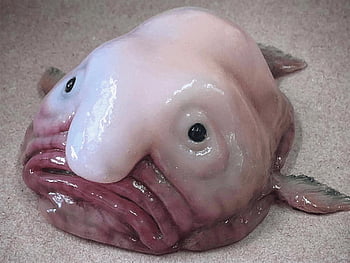The blobfish (Psychrolutes marcidus) is a deep-sea fish that is known for its unique appearance and habitat.
Blobfish Classification and Evolution
The blobfish, or Psychrolutes marcidus, is a deep-sea fish that is found off the coast of Australia, New Zealand, and Tasmania. It is known for its distinctive appearance, which has led it to be nicknamed the "world's ugliest fish."
Classification:
The blobfish belongs to the family Psychrolutidae, which contains about 30 species of deep-sea fish. Within this family, the blobfish is classified as part of the genus Psychrolutes, which contains about 20 species. The blobfish is the most well-known species in this genus.
Evolution:
The blobfish has likely been in its current form for millions of years. Fossil evidence of deep-sea fish similar to the blobfish has been found dating back to the Eocene epoch, which occurred between 56 and 33.9 million years ago. These fish were adapted to living in the deep-sea environment, which has remained largely unchanged over the past several million years.
The blobfish's unique appearance is a result of its adaptation to living in the deep sea. The high pressure and low temperatures of this environment require fish to have a gelatinous body that can withstand the pressure without collapsing. The blobfish's lack of a swim bladder also allows it to conserve energy in the low-oxygen environment of the deep sea.
In summary, the blobfish is a deep-sea fish belonging to the family Psychrolutidae and the genus Psychrolutes. Its unique appearance is a result of its adaptation to living in the deep-sea environment, which has remained largely unchanged over millions of years.
Blobfish Anatomy and Appearance
Lack of swim bladder: Unlike most other fish, the blobfish does not have a swim bladder, which is an organ that helps fish regulate their buoyancy. Instead, the blobfish uses its gelatinous body to maintain its position in the water column.
Flattened shape: The blobfish has a flattened, somewhat oval shape, with a wide head and a tapered tail. Its body is covered in loose, flabby skin that hangs in folds around its mouth.
Pale pink or gray coloration: The blobfish's coloration is a pale pink or grayish-white, which helps it blend in with the soft sediment on the seafloor. Its skin is also covered in small, hair-like projections that may help it detect prey in the water.
Large head and mouth: The blobfish has a disproportionately large head and mouth, which it uses to catch prey. Its mouth is able to stretch to several times its normal size, allowing it to swallow prey whole.
Blobfish Distribution and Habitat
Distribution:
Habitat:
Blobfish Behaviour and Lifestyle
Habitat: The blobfish is found in the deep-sea waters off the coast of Australia, New Zealand, and Tasmania, in depths ranging from 600 to 1,200 meters (2,000 to 3,900 feet). Its habitat is characterized by cold temperatures, high pressure, and low oxygen levels.
Diet: The blobfish is a carnivorous fish that feeds on a variety of prey, including crabs, lobsters, and other deep-sea creatures. It has a large mouth that is capable of stretching to several times its normal size, allowing it to swallow prey whole.
Conservation status: The blobfish is listed as "Vulnerable" on the International Union for Conservation of Nature's Red List of Threatened Species. Its population is believed to be declining due to deep-sea trawling, which can damage its habitat and accidentally catch blobfish as bycatch.
Nickname: The blobfish is sometimes called the "world's ugliest fish" due to its unusual appearance. However, beauty is in the eye of the beholder, and many people find the blobfish to be fascinating and unique.
Adaptations: The blobfish has a number of unique adaptations that help it survive in the extreme conditions of the deep sea. Its gelatinous body, lack of a swim bladder, and large head and mouth are all adaptations that help it maintain its position in the water column, catch prey, and survive in the low-oxygen, high-pressure environment of the deep sea.
Myth: The blobfish's unusual appearance has led to some myths and misconceptions about the fish. For example, some people believe that the blobfish looks very different in its natural habitat than it does when it is brought to the surface, but this is not true. The blobfish looks the same whether it is at the surface or in the deep sea.
Blobfish Reproduction and Life Cycles
Slow-moving: Due to the low oxygen levels and high pressure of its habitat, the blobfish is adapted to a slow-moving lifestyle. It conserves energy by moving slowly and using as little energy as possible.
Feeding behavior: The blobfish is a carnivorous fish that feeds on a variety of prey, including crabs, lobsters, and other deep-sea creatures. It has a large mouth that is capable of stretching to several times its normal size, allowing it to swallow prey whole. However, due to the low food availability in its deep-sea habitat, the blobfish is likely an opportunistic feeder and may go for long periods of time without feeding.
Reproduction: Very little is known about the blobfish's reproductive behavior, but it is believed to have a slow reproductive rate due to its deep-sea habitat and limited resources. Females likely lay a small number of eggs, and the young may take a long time to mature.


Comments
Post a Comment